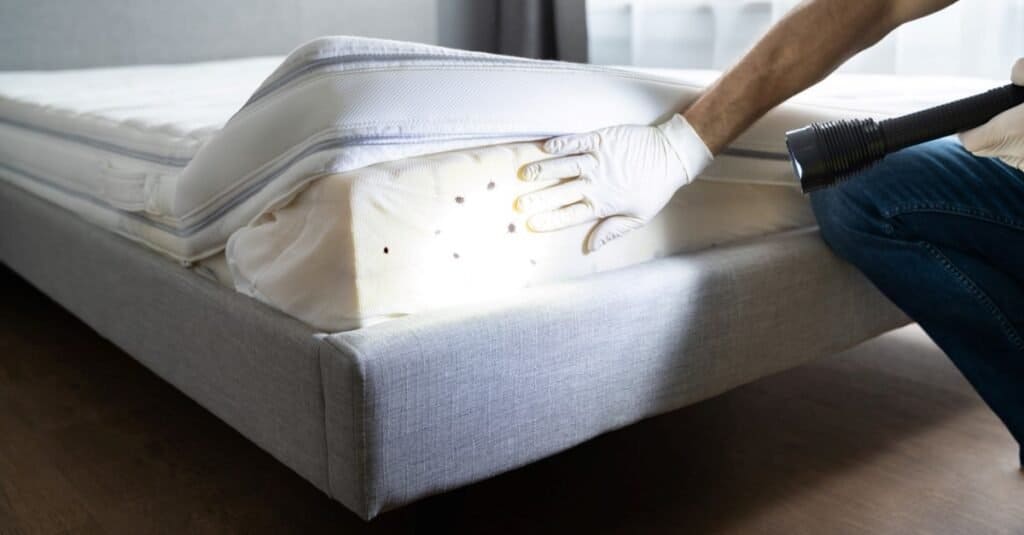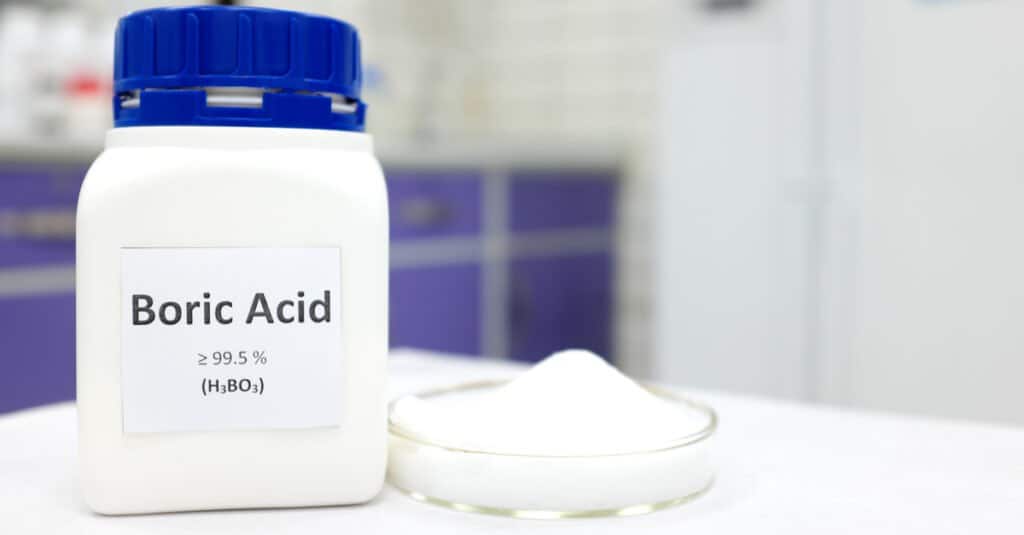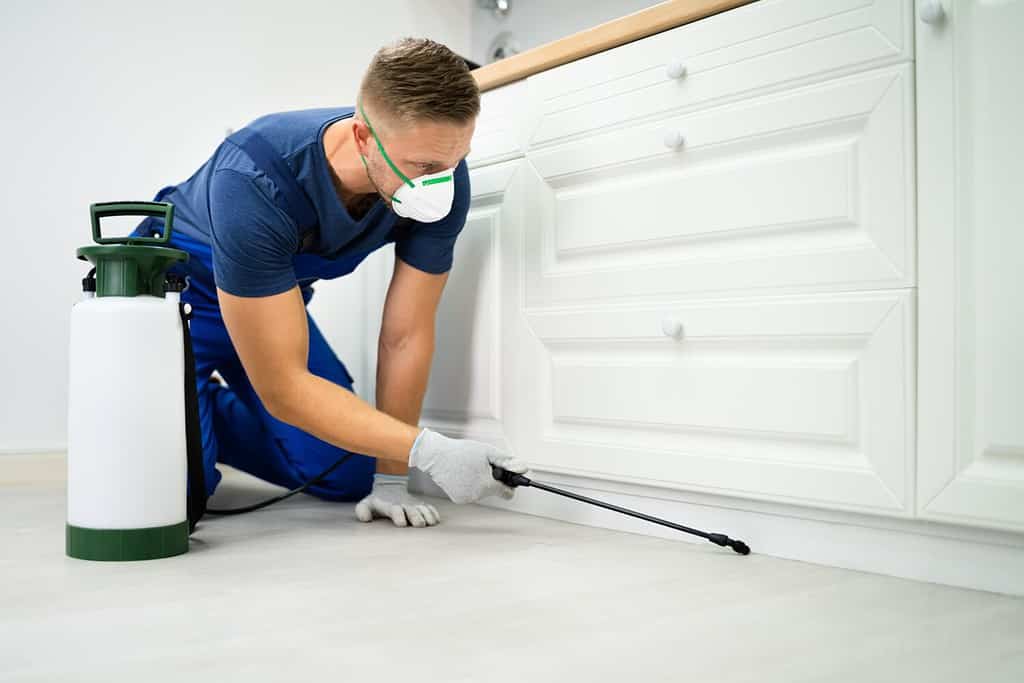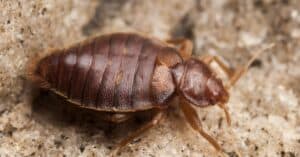The very mention of bed bugs can cause an itchy sensation to crawl over your skin and scalp.
Bed bugs, also known by their scientific name Cimex lectularius, have a reputation of being one of the world’s major pests. Hard to spot and easy to proliferate, bed bugs pose minor health risks and can incur thousands of dollars in cleaning fees if an infestation gets out of hand.
If you have bed bugs — or simply want to know the best way to get rid of them forever, keep reading to discover the 10 solutions that kill bed bugs permanently.

10 Solutions that Kill Bed Bugs Permanently
Forget about quick fixes and band-aids; the following solutions have an expert’s seal of approval to work at ridding furniture, clothes, bedding, and mattresses of bed bugs long-term.
1. Consistently Vacuum Affected Areas and Hiding Places

Vacuuming mattresses several rounds can make bed bugs go away for good.
©Andrey_Popov/Shutterstock.com
During your normal cleaning routine, vacuum everywhere. And everything. Will vacuuming grab every bed bug on the first go? Probably not; nor will it kill them immediately. Make a couple of rounds of deep vacuuming for wall corners, furniture, and mattresses, and then take the vacuum bag outside for disposal. The last thing you want to do is keep live bed bugs and their eggs in your vacuum — they could hatch in the bag and infect more of your home the next time you vacuum if you forget.
Jordan Foster, a pest control expert from one of the UK’s fastest-growing home services, Fantastic Pest Control, has 10 years of experience in eradicating bed bugs from homes. He told A-Z Animals, “Regular vacuuming of infested areas, such as mattresses, box springs, and cracks in furniture, can help remove live bed bugs and their eggs. The vacuum bag or canister should be emptied into an outdoor trash bin after use.”
Vacuuming regularly ensures you get every bug and its eggs from the colony off your possessions and into the trash. You can dry vacuum, or you can get a steamer vacuum. Heat kills bed bugs, so this proves extra effective.
2. Chemical Treatments

The EPA approves boric acid as a treatment for bed bugs.
©sulit.photos/Shutterstock.com
According to the Environmental Protection Agency, several pesticides are approved and registered for use against bed bugs. They include:
- Chlorfenapyr.
- Cold-pressed neem oil.
- Diatomaceous earth.
- Boric acid.
- Pyrethrins and pyrethroids (like foggers).
Megan Wede, co-owner and operator of Done Right Pest Solution, has specialized in bed bug, cockroach, and mice extermination for years. In her experience, chemical treatments are the end-all, be-all solution to bed bugs. In conversation with A-Z Animals, Wade explained how her experience with multi-family housing properties gives her the confidence to say she and her team know the best permanent solution to ridding a home of bed bugs.
“We treat for bed bugs nearly every single day, emphasizing in multi-family housing properties which have more pest issues simply due to the close proximity and many, many shared walls of multi-unit properties,” she started.
“While many companies will advocate for a heat treatment or a fumigation treatment of bed bugs, we’ve found that these methods are not 100% effective. “Bed bugs hide in wall voids, so when the temperatures get high in a unit or a fumigant is set off, they are safe within the walls. They are extraordinary pests that can be pretty resilient.”
Wade went on to say, “We have found that in our experience that chemical treatments are the way to go. We have not had one bed bug service not be effectively eradicated.”
As great as chemical treatments like insecticides are, it’s not always the best idea for a hometown to attempt one themselves. “I would absolutely recommend hiring a licensed and warrantied pest control company to come service your home or unit if you have bed bugs,” said Wade.
3. Heat Treatments

Bed bugs of all life stages will die at 115-degree heat exposure for over seven minutes.
©YakobchukOlena/iStock via Getty Images
Whether you choose steaming or another method of heat-treating your possessions, bed bugs can’t handle direct heat. It’s not that they don’t like it; the opposite is true. Heat draws in the bed bugs, and they become trapped. Once the temperature rises to 115 degrees Fahrenheit or higher, an hour will kill all bed bug adults, nymphs, and eggs.
“A high temperature will kill bed bugs. During a professional heat treatment, the temperature in your home rises to a level that eliminates bed bugs and their eggs. Unlike chemical treatments, this method can penetrate hiding places. Getting rid of bed bugs with heat treatment is the fastest and most effective method.”
Based on Wade’s experience, though, the opposite is true. Depending on your home’s structure, a combination of heat and chemical treatments may be the right solution to kill bed bugs permanently.
4. Washing and Drying Fabric on High Heat

Wash and dry your clothes in high heat to kill any lingering bed bugs for good.
©Hiroko Yoshida/iStock via Getty Images
Like you’d do with a lice infestation, clean all the fabric you can get your hands on. This includes bed sheets, covers, comforters, pillows, clothes, and curtains.
“Clean your bedding, curtains, and clothing well by washing them in hot water and drying them on high heat. Bed bugs and their eggs can be killed by steam-cleaning carpets and upholstery,” suggested Foster.
When washing and drying, make sure the cycles last at least 40 minutes. The longer and hotter you can make both the washer and dryer, the better. Similar to the heat treatments mentioned above, bed bugs like heat but their bodies can’t handle temperatures above 115 degrees.
5. Seal Unwashable Pieces

Place unwashable furniture pieces in plastic bags to remove the carbon dioxide source for bed bugs.
©Africa Studio/Shutterstock.com
You’ve washed and tried all the fabric pieces you can, but what can you do about the bed frame, armoire, or chair that doesn’t fit in the wash?
Seal them up. That’s right — put it in a plastic case for up to a year to suffocate the bed bugs and their eggs. Don’t try to open up the plastic case after a few months, either; this might let any live bed bug out, or give it more carbon dioxide to live.
If sealing the furniture is too cumbersome, you can consider getting it professionally cleaned or simply throwing it away. However, make sure to label a piece as “bed bugs” if you put it outside of your home so you don’t accidentally infest another person’s dwelling with your pesky nuisances.
6. Fill Wall Cracks

Caulk, wood filler, and plaster will fill in small crevices that bed bugs use as hiding places.
©Visivasnc/iStock via Getty Images
Did you know that bed sheets, upholstery, and couches aren’t the only places bed bugs go besides beds? They’re resilient nuisances, finding ways to stay alive even amid fumigation. Bed bugs can and will scurry from sight into small cracks to keep themselves alive, so filling any cracks you see in the wall can rid bed bugs of safe habitat. Instead, they’ll need to find somewhere in a room to hide — which makes chemical, heat, and other treatments much more effective.
What can you fill your walls with? It depends. If you find a nest under wallpaper, rip the paper off to see the extent of the nest and then cover their travel paths with caulk. Make sure you get each pathway. Removing the avenues they use to get around will confuse the bed bugs and rob them of a hiding place — making it easier to find and eradicate the stragglers.
7. Call the Professionals

Pest control professionals know how to discover how extensive a colony of bed bugs is.
©Andrey_Popov/Shutterstock.com
DIY methods are great and inexpensive (for the first few times), but tend to offer short-term solutions. If you’re serious about finding a solution that kills bed bugs permanently, it may be time to consider professional help.
“It can be challenging to eradicate bed bug infestations completely, and it may require multiple treatments and diligent efforts to eradicate them permanently,” Foster shared. “Professional pest control services are often the most reliable way to resolve a bed bug infestation on a long-term basis.”
Not only do professionals have the experience; but their tools and insecticides work better than what a homeowner or renter can find at the local home improvement store.
8. Declutter

Keeping your pantry free from clutter is one way to remove bed bug hiding place.
©Kristen Prahl/Shutterstock.com
Believe it or not, decluttering your home has the potential to solve a bed bug problem long-term. Warm-blooded animals (like humans or pets) and carbon dioxide, not dirty homes, attract bed bugs. However, once a bed bug has made its home in your home, they want to find somewhere dark where they can hide that food sources (you and your family) will sit near. Heck, bed bugs will even make themselves a home in books if you have a shelf near your bed or couch.
If you have piles and piles of junk around where you sleep, lounge, or watch TV, you may have inadvertently prepared a nice home for bed bugs. Ridding your home of clutter gives bed bugs fewer places to hide, making it easier for you to spot an infestation.
9. A Combination of Techniques

A mix of insecticides, heat treatments, and more can work together for permanent bed bug removal.
©Worledit/ via Getty Images
Homes with serious bed bug infestation might benefit from more than one method to kill bed bugs permanently. However, remember to use only approved chemicals, insecticides, and steamers — and know both the safety information and how they’ll interact with each other before use.
“The use of insecticides that are specifically designed to target bed bugs may be used,” Foster recommended. “The treatments are typically applied to cracks, crevices, and other places where bed bugs hide. To eliminate all life stages of bed bugs, follow-up treatments are necessary.”
He followed up with, “Protect mattresses and box springs with bed bug-proof encasements. Bed bugs can be trapped inside and prevented from feeding or escaping.”
After all, if multiple solutions guarantee an end to the infestation, why not try it?
10. For Prevention Only: Home Inspections

Professional inspectors will look for signs of a colony during an annual check-up.
©Michael O’Keene/Shutterstock.com
Whether you’ve never had bed bugs — or you’ve just rid your home of an infestation — a home inspection by a pest control expert every few months provides peace of mind that the colony isn’t returning. Check-ups — by you or a professional inspector — remain important after you’ve traveled. Said Foster, “Take precautions to prevent bringing bed bugs home when you travel. Inspect your accommodations for signs of bed bugs, and take precautions to prevent bringing them back with you.”
When inspecting a home for bed bugs, pest control experts will come to your home and complete an exhaustive search of all the common and unusual places bed bugs hide. This includes beds, couches, nightstands, wheelchairs, baseboards, carpets, and more.
With a periodic check-up, you can sleep easy (and bite-free!) that bed bugs haven’t found their next meal in your home.
Bed Bugs Be Gone for Good
Bed bugs are more than an annoying nuisance; they’re a threat to human and pet health with bites that can cause infection or illness. By following one, or a combination of several, of the techniques listed above, you should be able to get rid of bed bugs permanently.
Summary of 10 Solutions that Kill Bed Bugs Permanently
| Number | Solutions that Kills Bed Bugs |
|---|---|
| 1 | Consistently Vacuum Affected Areas and Hiding Places |
| 2 | Chemical Treatments |
| 3 | Heat Treatments |
| 4 | Washing and Drying Fabric on High Heat |
| 5 | Seal Unwashable Pieces |
| 6 | Fill Wall Cracks |
| 7 | Call the Professionals |
| 8 | Declutter |
| 9 | A Combination of Techniques |
| 10 | For Prevention Only: Home Inspections |
The photo featured at the top of this post is © Jay Ondreicka/Shutterstock.com
Thank you for reading! Have some feedback for us? Contact the AZ Animals editorial team.







